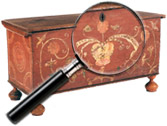|
|
Harold Rudolf (circa 1850(?)-1944)
Harold Rudolph arrived in New Orleans in 1873 and opened a portrait studio with his brother-in-law Burtus Ducomman. After the tragic suicide of Ducomman, Rudolph largely abandoned his work as a portraitist and turned to painting landscapes. The untouched wilderness along the Missouri River and bayous of Southern Louisiana attracted the artist’s attention. In the Louisiana State Museum’s painting “Indian Lodge on Bluffs”, the juxtaposition of the American Indians and [...] Click here to continue reading.
Peter Paul Rubens (Flemish, 1577 to 1640)
Peter Paul Rubens was a Flemish painter and draftsman. Rubens was an important and influential artist, as well as an international diplomat, successful businessman, devout Catholic, and an intellectual fluent in six languages. After study with local Antwerp painters, Rubens studied in Italy, copying works from antiquity and Renaissance masters. Rubens is famed for an energetic Baroque style that blends northern European realism with the grandeur [...] Click here to continue reading.
Royal Doulton Porcelain Figures
The line of Royal Doulton figures was introduced in 1913 under the supervision of the Company’s art director, Charles Noke. Early subjects drew their inspiration from many sources: pretty ladies, British street and country life, literature, history and the orient. Later years saw the addition of musicians, sports as important themes as well as the use of current fashion trends in clothing, hairstyles, etc.
Harry Nixon, in charge of Doulton’s [...] Click here to continue reading.
Flora Danica Dinnerware
One of the oldest, and perhaps most prestigious dinnerware sets in the world is the Flora Danica set ordered in the late 18th century by Crown Prince Frederick (later King Frederick IV) as a gift to Russian Empress Catherine II the Great.
The design source for the dinnerware was the Flora Danica folio of all wild flora to be found in Denmark, begun in 1761 by George Christian Oeder, director of [...] Click here to continue reading.
Jamini Roy (Indian, 1887 to 1972)
Jamini Roy emerged as one of the most important Indian painters of the twentieth century, creating emblematic images of Indian culture that fuse modernity with historical and folk traditions. Roy was born in a small Bengali village, and the rich cultural traditions of that area of his are infused in his work. He received formal training at the Government School of Art in Calcutta, but by the 1920s [...] Click here to continue reading.
Alexander Roux, Cabinetmaker
The French cabinetmaker Alexander Roux (1813 to 1886) opened his Manhattan cabinet firm in 1836. Specializing in Victorian furnishings in the Renaissance, Gothic and Rococo Revival styles, Roux worked in New York City until his retirement in 1881. Alexander Roux’s son, Alexander J. and his brother Frederick joined the business and continued operating the firm through 1898 at various locations.
The firm used a variety of elaborate engraved marks and labels. [...] Click here to continue reading.
Harry Ross
Harry Ross was from Norway, Maine and before his death was well known as a carver throughout North America. His clients included Clark Gable, Roy Rogers and Ernest Hemmingway. In 1949 Ross won the International Decoy Makers Contest with his carvings.
Roseville Pottery Wisteria Pattern
Roseville’s Wisterian pattern presents a triangular cluster of lavender blossoms on stem with opposing green leaves on adjacent stems on heavily textured bark-like background, 1933. Colors include brown, brown/yellow/green, medium blue, and deep blue. Mark: Large and small silver sticker. 18 total shapes: 15 used once, one, a bowl/console bowl, shape #243, came in three sizes. A 5″ urn, hanging basket and the wall pocket were unnumbered.
Roseville Wincraft Pattern
The Roseville Wincraft pattern originated in 1948. A middle period line named for Roseville President Robert Windisch, who believed that a dramatic change was needed in Roseville’s typical soft glazes for post-war tastes. Wincraft comes in a wide variety of floral and Oriental motifs – including a panther – all with a high gloss finish typical of 1950s decorative styles. Some of the floral designs were used on other Roseville lines [...] Click here to continue reading.
Roseville Pottery Teasel Pattern
Roseville’s Teasal pattern presents embossed seed pods, stems and branches in monochrome matte or crystalline glaze, 1936. Colors are quite varied: tan, brown, medium blue, pale blue, deep rose, sunset (peach), and possibly others. Some colors had gold highlights. Mark: Roseville impressed or silver paper label. 19 total shapes: 17 used once and two shapes, the bowl and urn, came in 4″ and 5″ sizes. There are no unnumbered Teasel [...] Click here to continue reading.
|
Recent Articles
- Charles Alfred Meurer – American Artist & Tromp L’Oeil Artist
- Sendak, Maurice – American Artist & Writer
- Godie, Lee – American Artist
- Davis, Vestie – American Artist
- Bartlett, Morton – American Artist
- Mackintosh, Dwight – American Artist
- Evans, Minnie Jones – African-American Artist
- Mumma, Ed (Mr. Eddy) – American Artist
- Nice, Don – American Artist
- Savitsky, John (Jack) – American Artist
- Gordon, Harold Theodore (Ted) – American Artist
- Dial, Thornton – African-American Artist
- Doyle Sam – American Artist
- Johnson, Lester Frederick – American Artist
- Finster, Howard – American Artist
|
|
